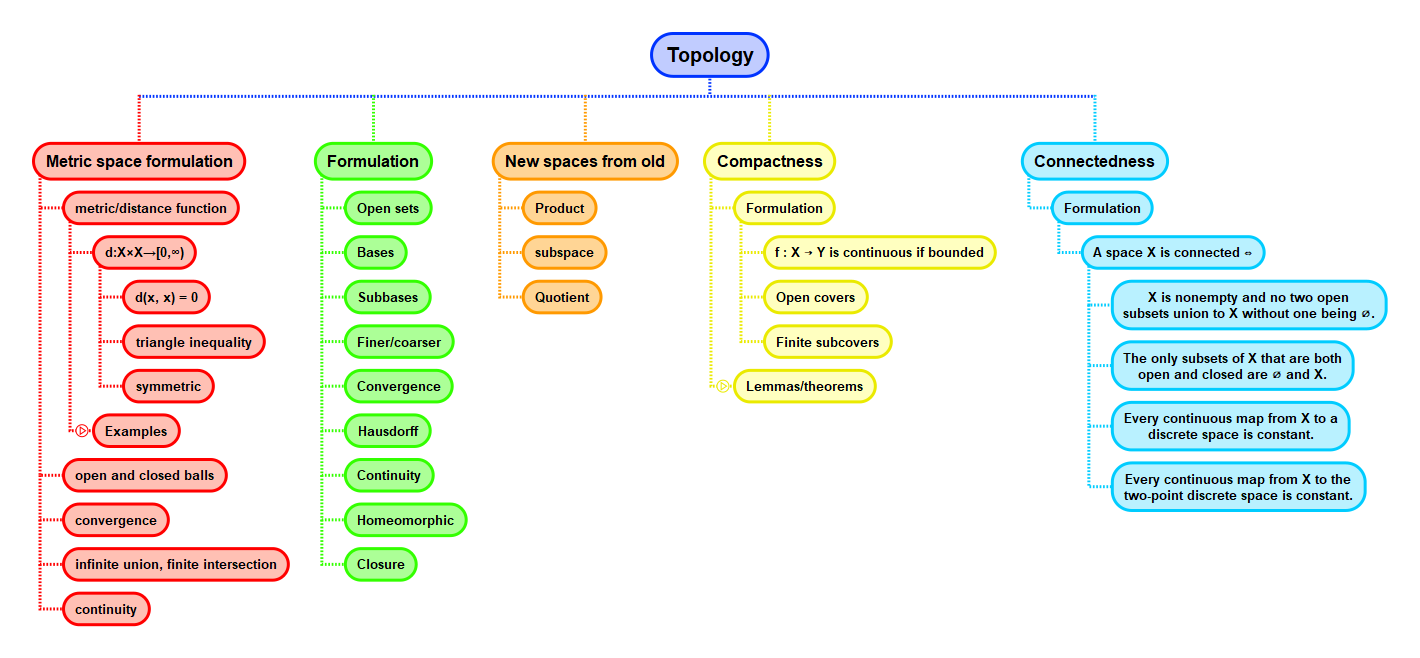Path-connectedness. 4 statements
Path-connectedness implies connectedness, the converse is not generally true through.
The topologist's sine curve is an example of a space that is connected but not path-connected. Leinster covers the topologist's sine curve in some detail.
Below, we introduce an iff statement that does hold. It has the form: something ∧ connected ⟺ path-connected. After this, 3 conditions that each imply path-connectedness are presented.
1. Path-connected ⟺ connected and all points have a path-connected neighbourhood
Let \( X \) be a topological space. \( X \) is path-connected if and only if \( X \) is connected and every point of \( X \) has at least one path-connected neighbourhood.
2. Corollary. Every connected open subset of \( \mathbb{R}^d \) is path-connected.
3. Path-connectedness and continuous functions
Let \( f : X \to Y \) be a continuous map of topological spaces. If \( X \) is path-connected, then so is \( fX \).
4. Path-connectedness and products
The product of two path-connected spaces is path-connected.
Proofs
Path-connected ⟺ connected and all points have a path-connected neighbourhood
Let \( X \) be a topological space.
Forward implication
Assume that \( X \) is path-connected. As shown in a previous card, \( X \) is connected as it is path-connected. In addition, we have a path-connected neighbourhood for every point as the set \( X \) is a neighbourhood for every point and \( X \) is path-connected.
Reverse implication
Assume \( X \) is connected and all points have a path-connected neighbourhood. Let \( x \in X \) and let \( U \) be the set of all elements having a path to \( x \):
Claim: both \( U \) and \( X \setminus U \) are open in \( X \). Show this in two parts.
- \( U \) is open
- Let \( y \in U \). By assumption, there is an path-connected neighbourhood \( W \) of \( y \). Let \( w \in W \). There is a path from \( x \) to \( w \) as we can join a path from \( x \) to \( y \) and a path from \( y \) to \( w \). Thus, \( W \subset U \). As every element of \( U \) has a neighbourhood contained in \( U \), \( U \) must be open (A2.9 in Leinster's notes).
- \( X \setminus U \) is open
- Let \( y \in X \setminus U \). By assumption, there is a path-connected neighbourhood \( W \) of \( y \). \( W \cap U = \emptyset \), as if there was an element \( t \in W \cap U \) we could find a path from \( x \) to \( y \) by joining the path from \( x \) to \( t \) and the path from \( t \) to \( y \); but such a path would contradict \( y \notin U \). We can now state that \( W \in X \setminus U \), as \( W \subseteq X \) and \( W \cap U = \emptyset \). As every element of \( X \setminus U \) has a neighbourhood contained in \( X \setminus U \), \( X \setminus U \) must be open (again by A2.9).
So, we have both \( U \) and \( X \setminus U \) being open. However, \( X \) is connected, so one of the sets must be empty and the other must equal \( X \). \( x \) itself is in \( U \), so \( U = X \). \( U \) is path-connected by definition, so \( X \) is path-connected.

Context

